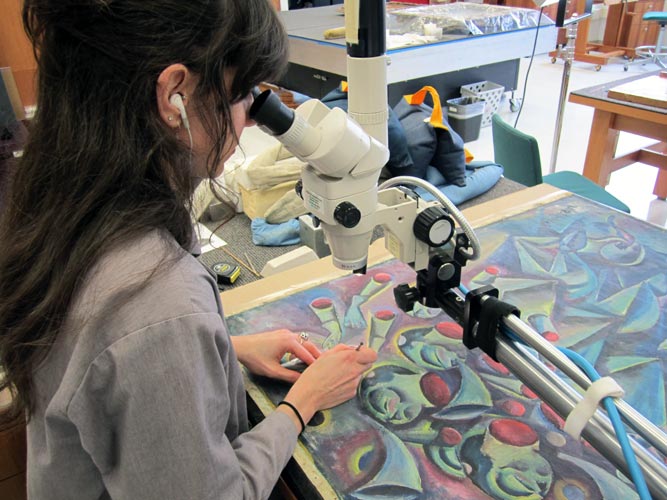The Harvard Art Museums have trained scores of museum leaders who have gone on to make remarkable contributions to the curatorial, conservation, and education fields. We offer a number of opportunities for emerging graduate and postgraduate scholars interested in the production and presentation of original scholarship within the museum context. In this regular series of interviews, we catch up with these museum professionals to see where they are now.
Gabriel Dunn was a painting conservation fellow in the Straus Center for Conservation and Technical Studies from 2011 to 2012. On May 20, Gabriel will be back on campus to present the research she did as a recipient of the Baird Fellowship.
Q What is your current position? A I’m currently assistant paintings conservator at Whitten & Proctor Fine Art Conservation in Houston, Texas.
Q Can you tell us about your experience as a fellow in the Straus Center? A During my fellowship in paintings conservation at the Straus, I treated a variety of paintings in preparation for installation in the new Harvard Art Museums. I enjoyed every aspect of my fellowship, and I especially loved working with the amazing staff. Not only are they all highly knowledgeable in their specific fields, but they’re willing to go above and beyond to support the fellows, which allowed me to excel in all my projects.
Q You received the Baird Fellowship to support a research project after your time at the Straus Center. Can you tell us about the work you did with that award? A One of the works I treated during my fellowship year was Four Fallen Soldiers in Cosmic Space/Homunculus, a double-sided painting by the German artist Johannes Molzahn. It was so intriguing that I wanted to find out more about the artist and the painting—especially because Molzahn’s work is rare in the United States, and most of his works in Europe are privately owned.
After my time at the Straus, I received the Baird Fellowship, which gave me the funding to travel and continue my research. I was able to view works in the United States and in Germany, where I spent a great deal of time with the sole proprietor of the Johannes Molzahn Centrum Für Documentation Und Publication, in Kassel. While I was conducting my research, the infamous German art forger Wolfgang Beltracchi was revealed, which provided a curious twist to my studies.
It was a very exciting project, and I am greatly looking forward to presenting my research to the public this month.
Q How did your training at the Harvard Art Museums prepare you for the work you are doing now? A I learned how to sharpen my presentation skills. One of my supervisors pointed out that I should give a presentation as if I were telling a story: it should have direction, be exciting enough to draw the listener in, and come to a conclusion. I’ve approached all of my presentations since then with this advice in mind.
Q Was there a specific event during your training at the Harvard Art Museums that you found particularly powerful? A I would say completing my Straus fellowship research project, “Experimental and Innovative: Matisse Paintings from the Wertheim Collection” and the Baird Fellowship project, “Johannes Molzahn: Cubo-Futurist Abstractionist.” Both were interesting and revelatory and allowed me to learn from experts all over the world. I’m very thankful to the Straus Center, at the Harvard Art Museums, and the Baird Fellowship for supporting my work.





